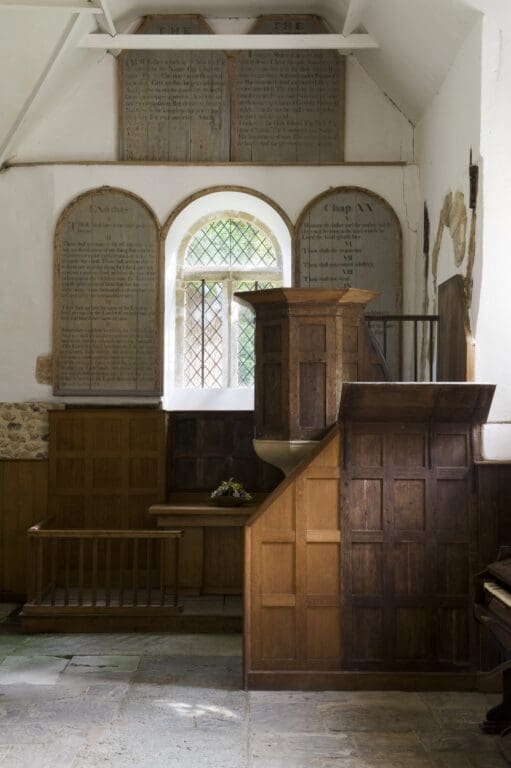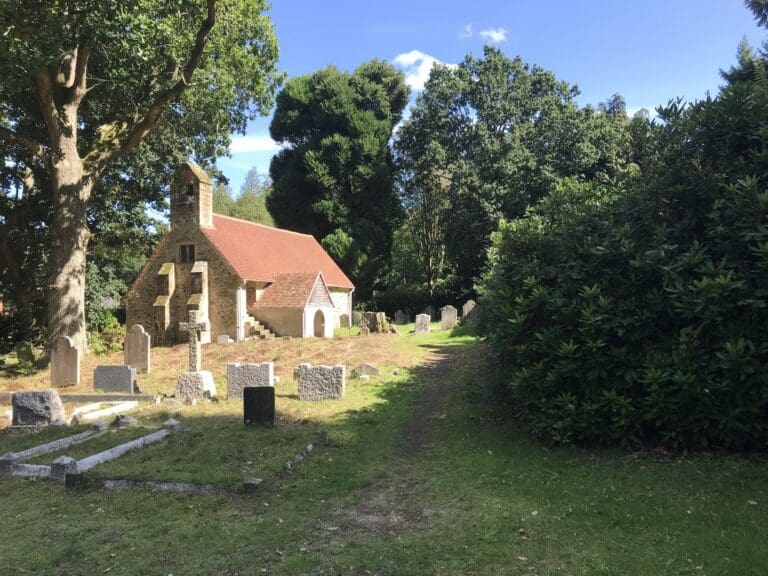
In 1994, whilst doing some repairs, some render fell off the south wall exposing herringbone masonry. At last, Tuxlith Chapel began to reveal its secrets. A north doorway was uncovered and a narrow round-headed window. These discoveries, coupled with thick walls and splayed windows, enabled us to place the origins of the current chapel at Milland in the 11th and 12th centuries.
The first documentary evidence we have of this charming building is in a will dated 1532, when Isabel Colpece left “ii shepe to the churche of Tuklyth”. However the building is much earlier than that, a blocked 12th century window having been discovered during repairs. This, together with ‘herringbone’ masonry in the north wall, points to a date within the Norman period (1066-1200).
It has been suggested that this building served as the original parish church of Trotton and was replaced by the present Trotton church early in the 14th century. If this is the case the chapel of Tuxlith certainly remained in use, as the Register begins in 1581, and the building itself shows signs of alteration.
In the 17th century a gallery was added, and although this was removed at a later date the stone stairs by which access was gained still remains outside. In the 18th century the most significant alteration – the addition of the north transept – was undertaken.
However, with the arrival of the railway and a subsequent growth in population the old church was considered too small and mean, and a new one was built to the west of the old in 1879. The old church then became a Sunday School room and continued as such for over fifty years. Sometime in the 1930s it was closed up and fell into complete ruin.
The roof fell in, render fell from the walls, and vegetation took hold. The building was eventually declared redundant in 1974. We stepped in to take the church into our care, and immediately made it weather-proof. At the same time, a friends group was created, they are still going strong and help us to care for this wonderful place.
The pulpit was restored in 1993. The altar, designed by Sir Hubert Bennett, is the latest addition to this much loved and now far from friendless.
Thanks to a grant from the Culture Recovery Fund in 2021 we were able to renew the ceilings internally, mend the leaky drains and re-render the porches. Our wonderful volunteers also organised the repair, cleaning and consolidation of the 18th-century Lord’s Prayer, Creed and Commandment boards.




Just as osteoarchaeologists can reveal secrets from a small piece of bone, the material evidence in a church building can help us understand who built it, and when. Eccesiastical historian John Vigar takes a look at the stone and construction techniques used at Tuxlith Chapel and what they reveal about the community who built the church, 900 years ago.
When we go inside a church, the impression we get is often of how it looked in the 19th century. However, at Tuxlith Chapel the structural changes and furnishings of the 18th-century interior have been largely preserved. John Vigar, ecclesiastical historian, explores the surviving Georgian features in this redundant church, from large light-filled windows and a new transept, to commandment boards and an enormous pulpit on a wine-glass stem, from which the parson could keep a close eye on the entire congregation, even those in private box pews.
Medieval Tuxlith Chapel was still thriving in the Georgian era, but as the 19th century progressed, cracks began to show. And by the early 20th century, this venerable building had fallen into complete disrepair. In the last part of our mini-series telling the story of one church through time, historian John Vigar investigates why this church, like so many others, was abandoned by the Victorians.
Please use these links if you would like to know more about the church and the surrounding area